Itinerary
It’s no wonder that all roads lead to the fascinating and maddening metropolis of Athens. Lift your eyes 200 feet above the city to the Parthenon, its honey-color marble columns rising from a massive limestone base, and you behold architectural perfection that has not been surpassed in 2,500 years. But, today, this shrine of classical form dominates a 21st-century boomtown. To experience Athens—Athína in Greek—fully is to understand the essence of Greece: ancient monuments surviving in a sea of cement, startling beauty amid the squalor, tradition juxtaposed with modernity. Locals depend on humor and flexibility to deal with the chaos; you should do the same. The rewards are immense. Although Athens covers a huge area, the major landmarks of the ancient Greek, Roman, and Byzantine periods are close to the modern city center. You can easily walk from the Acropolis to many other key sites, taking time to browse in shops and relax in cafés and tavernas along the way. From many quarters of the city you can glimpse “the glory that was Greece” in the form of the Acropolis looming above the horizon, but only by actually climbing that rocky precipice can you feel the impact of the ancient settlement. The Acropolis and Filopappou, two craggy hills sitting side by side; the ancient Agora (marketplace); and Kerameikos, the first cemetery, form the core of ancient and Roman Athens. Along the Unification of Archaeological Sites promenade, you can follow stone-paved, tree-lined walkways from site to site, undisturbed by traffic. Cars have also been banned or reduced in other streets in the historical center. In the National Archaeological Museum, vast numbers of artifacts illustrate the many millennia of Greek civilization; smaller museums such as the Goulandris Museum of Cycladic Art Museum and the Byzantine and Christian Museum illuminate the history of particular regions or periods. Athens may seem like one huge city, but it is really a conglomeration of neighborhoods with distinctive characters. The Eastern influences that prevailed during the 400-year rule of the Ottoman Empire are still evident in Monastiraki, the bazaar area near the foot of the Acropolis. On the northern slope of the Acropolis, stroll through Plaka (if possible by moonlight), an area of tranquil streets lined with renovated mansions, to get the flavor of the 19th-century’s gracious lifestyle. The narrow lanes of Anafiotika, a section of Plaka, thread past tiny churches and small, color-washed houses with wooden upper stories, recalling a Cycladic island village. In this maze of winding streets, vestiges of the older city are everywhere: crumbling stairways lined with festive tavernas; dank cellars filled with wine vats; occasionally a court or diminutive garden, enclosed within high walls and filled with magnolia trees and the flaming trumpet-shaped flowers of hibiscus bushes. Formerly run-down old quarters, such as Thission, Gazi and Psirri, popular nightlife areas filled with bars and mezedopoleia (similar to tapas bars), are now in the process of gentrification, although they still retain much of their original charm, as does the colorful produce and meat market on Athinas. The area around Syntagma Square, the tourist hub, and Omonia Square, the commercial heart of the city about 1 km (½ mi) northwest, is distinctly European, having been designed by the court architects of King Otho, a Bavarian, in the 19th century. The chic shops and bistros of ritzy Kolonaki nestle at the foot of Mt. Lycabettus, Athens’s highest hill (909 feet). Each of Athens’s outlying suburbs has a distinctive character: in the north is wealthy, tree-lined Kifissia, once a summer resort for aristocratic Athenians, and in the south and southeast lie Glyfada, Voula, and Vouliagmeni, with their sandy beaches, seaside bars, and lively summer nightlife. Just beyond the city’s southern fringes is Piraeus, a bustling port city of waterside fish tavernas and Saronic Gulf views.
Oraia (beautiful) is the word Greeks use to describe Nafplion. The town’s old section, on a peninsula jutting into the gulf of Argos, mixes Greek, Venetian, and Turkish architecture; narrow streets, often just broad flights of stone stairs, climb the slopes beneath the walls of Acronafplia. Tree-shaded plazas surround neoclassic buildings. The Palamidi fortress—an elegant display of Venetian might from the early 1700s—guards the town. Nafplion deserves at least a leisurely day of your undivided attention, and you may want to spend several days or a week here and use the city as the base from which to explore the many surrounding ancient sights.
Monemvasia boasts a varied and colorful history that can be traced to the 8th-century when Greeks fleeing the Slav invasion of Lakonia found refuge here. In its heyday it controlled sea travel between the Levant and European shores. The wall-encircled Lower Town extends along the slopes of a 985-foot-high crag that projects into the sea on the east side of the Peloponnese. For centuries an impressive stronghold, population dwindled as the inhabitants moved to the mainland. But with the beginning of a restoration program aimed to preserve Monemvasia’s heritage, the Lower Town experienced a new lease on life, and people have begun to return. The Upper Town is situated on top of the Rock of Monemvasia. It is reached via a zigzagging, paved lane. An almost impregnable bastion in earlier days, it has been uninhabited for centuries, but still manages to preserve its magnificent appearance. Visitors today can explore the remains of the ancient citadel-castle and visit the church of Hagia Sofia. From the summit there is also a fantastic view of the surrounding area.
Milos or Melos is a volcanic Greek island in the Aegean Sea, just north of the Sea of Crete. Milos is the southwesternmost island in the Cyclades group. The Venus de Milo and the Asclepius of Milos were both found on the island, as were a Poseidon and an archaic Apollo now in Athens.
For better or worse, it can be difficult to reach Patmos—for many travelers, this lack of access is definitely for the better, since the island retains the air of an unspoiled retreat. Rocky and barren, the small, 34-square-km (21-square-mi) island lies beyond the islands of Kalymnos and Leros, northwest of Kos. Here on a hillside is the Monastery of the Apocalypse, which enshrines the cave where St. John received the Revelation in AD 95. Scattered evidence of Mycenaean presence remains on Patmos, and walls of the classical period indicate the existence of a town near Skala. Most of the island’s approximately 2,800 people live in three villages: Skala, medieval Chora, and the small rural settlement of Kambos. The island is popular among the faithful making pilgrimages to the monastery as well as with vacationing Athenians and a newly growing community of international trendsetters—designers, artists, poets, and “taste gurus” (to quote Vogue’s July 2011 write-up of the island)—who have bought homes in Chora. These stylemeisters followed in the footsteps of Alexandrian John Stefanidis and the English artist Teddy Millington-Drake who, in the early ’60s, set about creating what eventually became hailed as one of the most gorgeous island homes in the world. The word soon spread thanks to their many guests (who included Jacqueline Kennedy Onassis) but, happily, administrators have carefully contained development, and as a result, Patmos retains its charm and natural beauty—even in the busy month of August.
Syros is an island in the Aegean Sea, 78 miles (125 kilometres) southeast of Athens, and the administrative, commercial, intellectual and cultural centre of the Cyclades. Syros is 32 square miles (82.8 square kilometres) in area. Its largest towns are Ermoupoli, the capital of the island and Cyclades, Ano Syros and Vari. Although Syros belongs to the Cyclades islands, its architecture is more medieval than Cycladic. The beaches of Syros are especially inviting, and surrounded by many tourist facilities and accommodations.
It’s no wonder that all roads lead to the fascinating and maddening metropolis of Athens. Lift your eyes 200 feet above the city to the Parthenon, its honey-color marble columns rising from a massive limestone base, and you behold architectural perfection that has not been surpassed in 2,500 years. But, today, this shrine of classical form dominates a 21st-century boomtown. To experience Athens—Athína in Greek—fully is to understand the essence of Greece: ancient monuments surviving in a sea of cement, startling beauty amid the squalor, tradition juxtaposed with modernity. Locals depend on humor and flexibility to deal with the chaos; you should do the same. The rewards are immense. Although Athens covers a huge area, the major landmarks of the ancient Greek, Roman, and Byzantine periods are close to the modern city center. You can easily walk from the Acropolis to many other key sites, taking time to browse in shops and relax in cafés and tavernas along the way. From many quarters of the city you can glimpse “the glory that was Greece” in the form of the Acropolis looming above the horizon, but only by actually climbing that rocky precipice can you feel the impact of the ancient settlement. The Acropolis and Filopappou, two craggy hills sitting side by side; the ancient Agora (marketplace); and Kerameikos, the first cemetery, form the core of ancient and Roman Athens. Along the Unification of Archaeological Sites promenade, you can follow stone-paved, tree-lined walkways from site to site, undisturbed by traffic. Cars have also been banned or reduced in other streets in the historical center. In the National Archaeological Museum, vast numbers of artifacts illustrate the many millennia of Greek civilization; smaller museums such as the Goulandris Museum of Cycladic Art Museum and the Byzantine and Christian Museum illuminate the history of particular regions or periods. Athens may seem like one huge city, but it is really a conglomeration of neighborhoods with distinctive characters. The Eastern influences that prevailed during the 400-year rule of the Ottoman Empire are still evident in Monastiraki, the bazaar area near the foot of the Acropolis. On the northern slope of the Acropolis, stroll through Plaka (if possible by moonlight), an area of tranquil streets lined with renovated mansions, to get the flavor of the 19th-century’s gracious lifestyle. The narrow lanes of Anafiotika, a section of Plaka, thread past tiny churches and small, color-washed houses with wooden upper stories, recalling a Cycladic island village. In this maze of winding streets, vestiges of the older city are everywhere: crumbling stairways lined with festive tavernas; dank cellars filled with wine vats; occasionally a court or diminutive garden, enclosed within high walls and filled with magnolia trees and the flaming trumpet-shaped flowers of hibiscus bushes. Formerly run-down old quarters, such as Thission, Gazi and Psirri, popular nightlife areas filled with bars and mezedopoleia (similar to tapas bars), are now in the process of gentrification, although they still retain much of their original charm, as does the colorful produce and meat market on Athinas. The area around Syntagma Square, the tourist hub, and Omonia Square, the commercial heart of the city about 1 km (½ mi) northwest, is distinctly European, having been designed by the court architects of King Otho, a Bavarian, in the 19th century. The chic shops and bistros of ritzy Kolonaki nestle at the foot of Mt. Lycabettus, Athens’s highest hill (909 feet). Each of Athens’s outlying suburbs has a distinctive character: in the north is wealthy, tree-lined Kifissia, once a summer resort for aristocratic Athenians, and in the south and southeast lie Glyfada, Voula, and Vouliagmeni, with their sandy beaches, seaside bars, and lively summer nightlife. Just beyond the city’s southern fringes is Piraeus, a bustling port city of waterside fish tavernas and Saronic Gulf views.
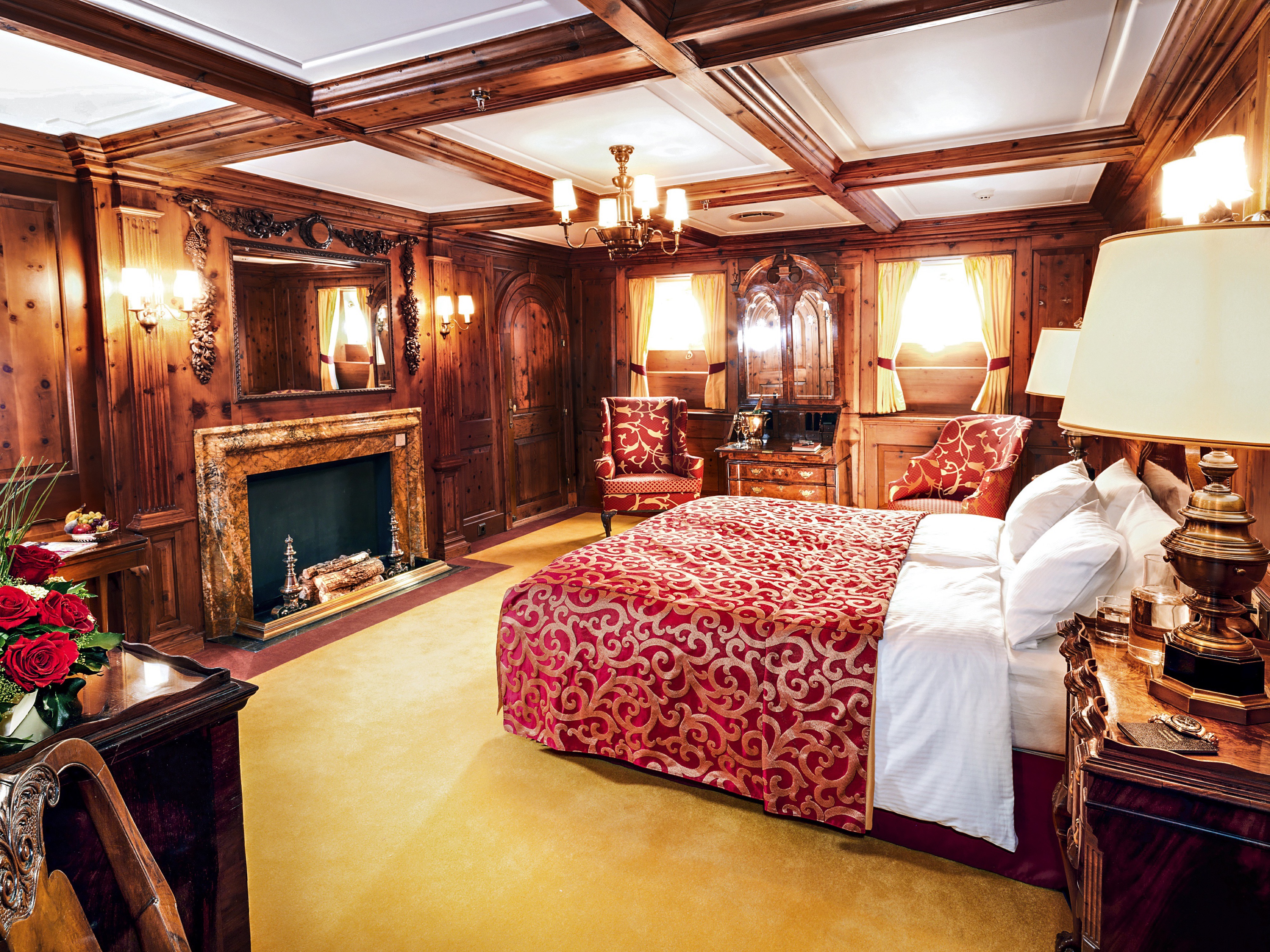
Cabin 1 – Probably the most legendary ship’s cabin ever. Marjorie has furnished the luxury suite herself. Whenever she traveled with the SEA CLOUD, these rooms were her home. Fireplace and bathroom in white Carrara marble, gold-plated swan necks as fittings, valuable Louis Philippe chairs, a large bed of varnish in old white decorated with gold, elaborate ceiling ornaments and a room-high dressing mirror: the furnishings she selected with exquisite taste reflect the successful American entrepreneur’s desire to spend time on her private yacht in a luxurious ambience.
Cabin 2 – In addition to her exquisite taste, Marjorie’s attention to detail is evident in the interior of the owner’s cabins. This is also reflected in the suite of her first husband Edward Hutton, who gave her the unique SEA CLOUD as a gift. The maple wood panelling gives the cabin a feeling of warmth and solidity; the light coffered ceiling gives the room a certain lightness. Special highlight: Edward Hutton’s beautiful “Bureau Bookcase” secretary with mirrored glass.
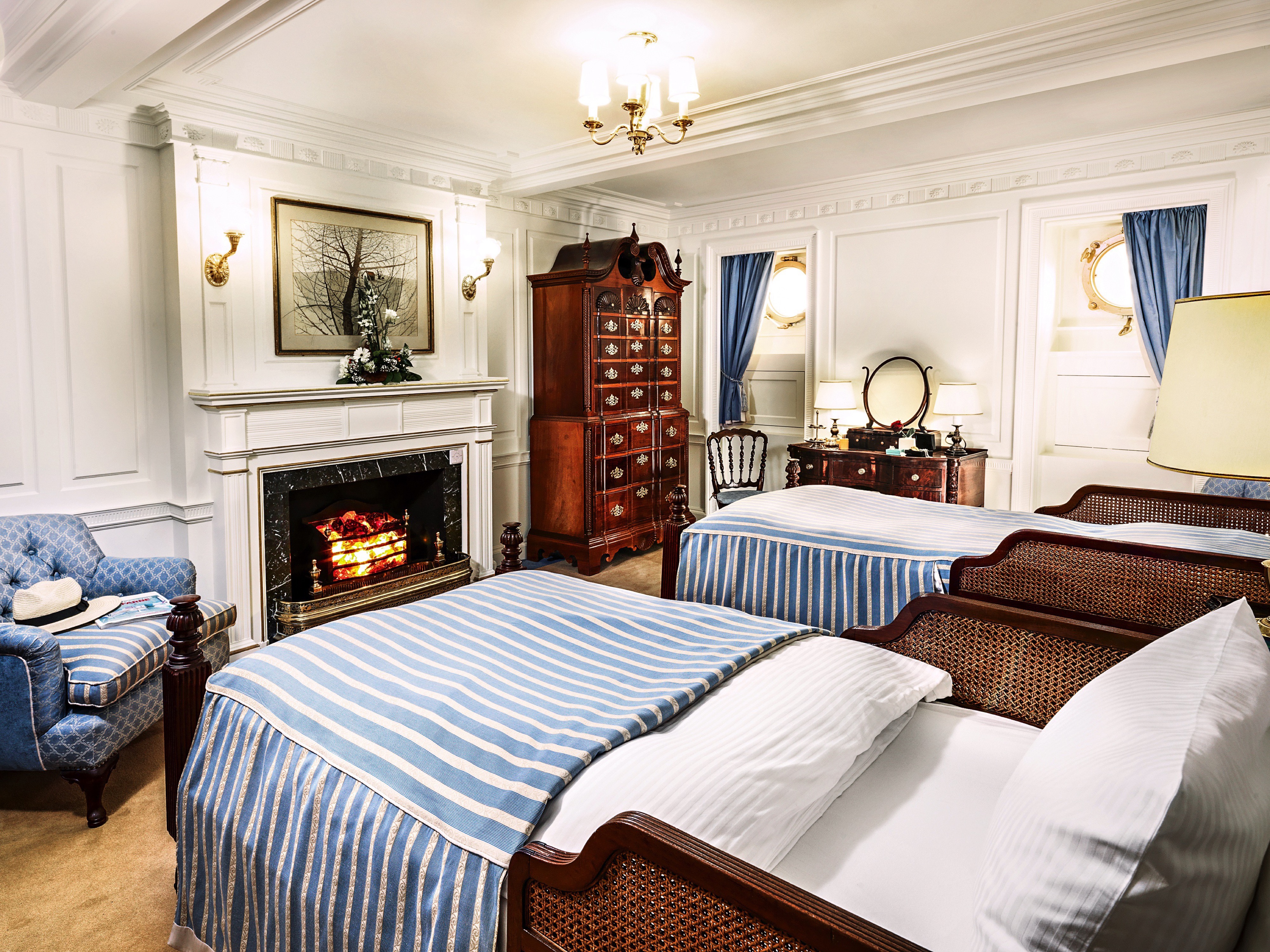
Cabin 3 – The original guestrooms reflected the generous hospitality of the Huttons. Each of these cabins was individually designed with carefully selected furniture and precious materials. The original colonial-style cabin no. 3 with its comfort is a testimony to this tradition. Famous personalities from the nobility, business and show business have already bedded their heads in this and the other spacious original cabins.
Cabin 4 – During the construction period of the SEA CLOUD in Kiel and later, when Marjorie already lived on board, she collected precious antiques all over the world. The original cabin No. 4 is one of the many examples of how skillfully she integrated the valuable pieces into the interior of her private yacht.
Cabin 5 – Marjorie’s declared goal was to make her family and her guests feel at home every minute on board the SEA CLOUD. Accordingly, she has designed the rooms like this de luxe original cabin to be spacious and comfortable. Spacious antique mahogany chests of drawers, marble in the bathroom and by the fireplace and antique unique pieces spread a cosy elegance.
Cabin 6 – Every vacation on the SEA CLOUD is also a journey through time. As in all original cabins, in this de luxe cabin you will feel transported back to the time of the elegant world customer of the 1930s. The selected antique mahogany furniture is small and delicate. Thanks to the color selection of the fabrics, the room has an extremely warm, sunny and light atmosphere.
Cabin 7 – As the first owner, Marjorie also furnished the SEA CLOUD with so much love for detail because she wanted to offer her daughter Dina Merrill a wonderful and safe home on board. This is especially noticeable in cabin no. 7: here Dina spent a large part of her childhood. The furniture made of fine maple has mahogany inlays. The unusual floor plan with the sloping fireplace makes the cabin appear even larger.
Cabin 8 – The original guestrooms reflected the generous hospitality of the Huttons and still contain the soul of the SEA CLOUD. Cabin no. 8 is a fine example for the character of the exclusive private yacht as which the ship was designed from the very beginning.
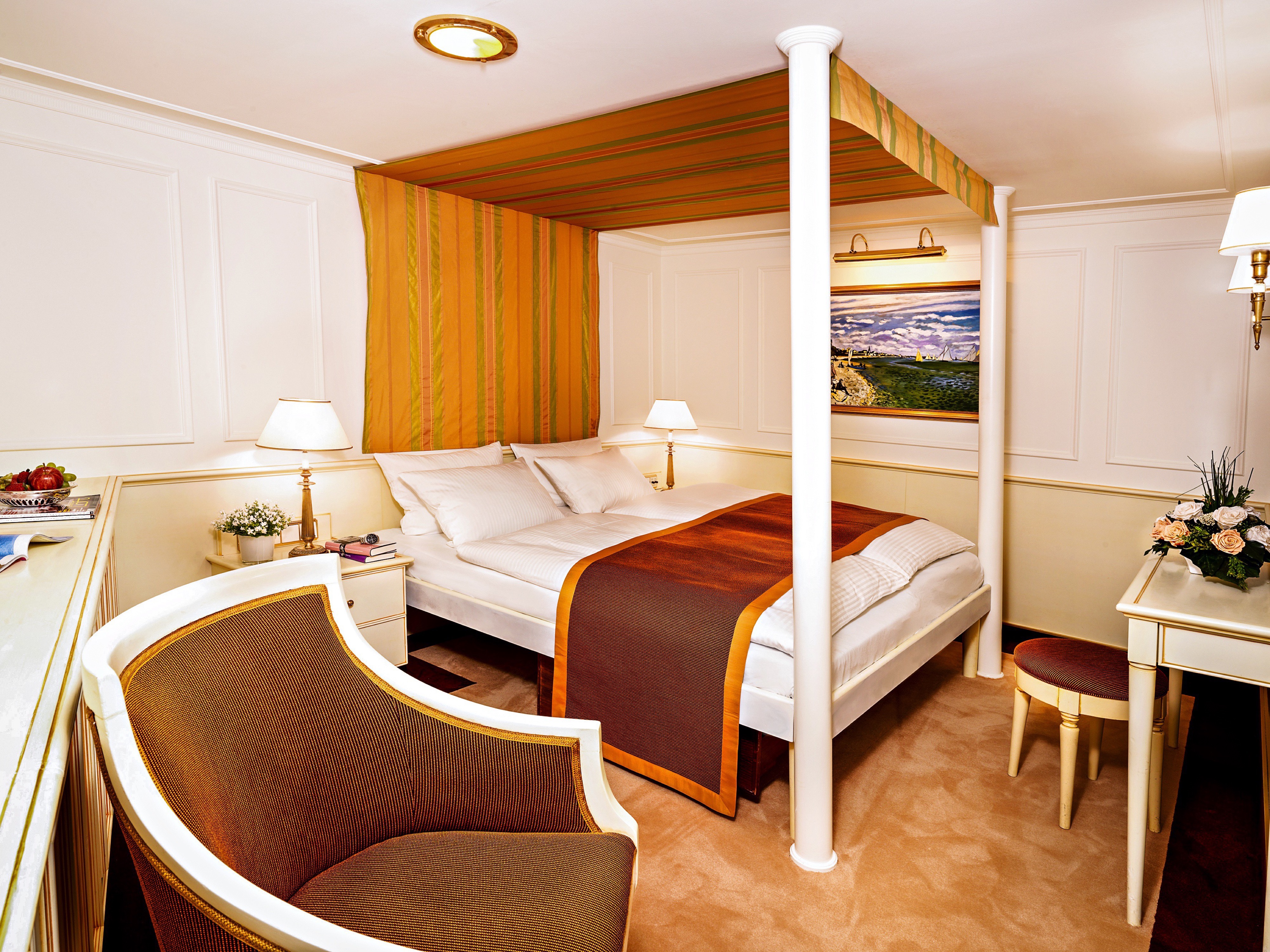
Cabins 9 and 10 are located in the original area on the main deck. Both rooms were redesigned into large De-Luxe outside cabins. The design is based on historical models with a modern accentuation and is kept in warm fabrics and wood tones. Both cabins are located at the end of the original area and are connected to the promenade deck by a separate staircase.
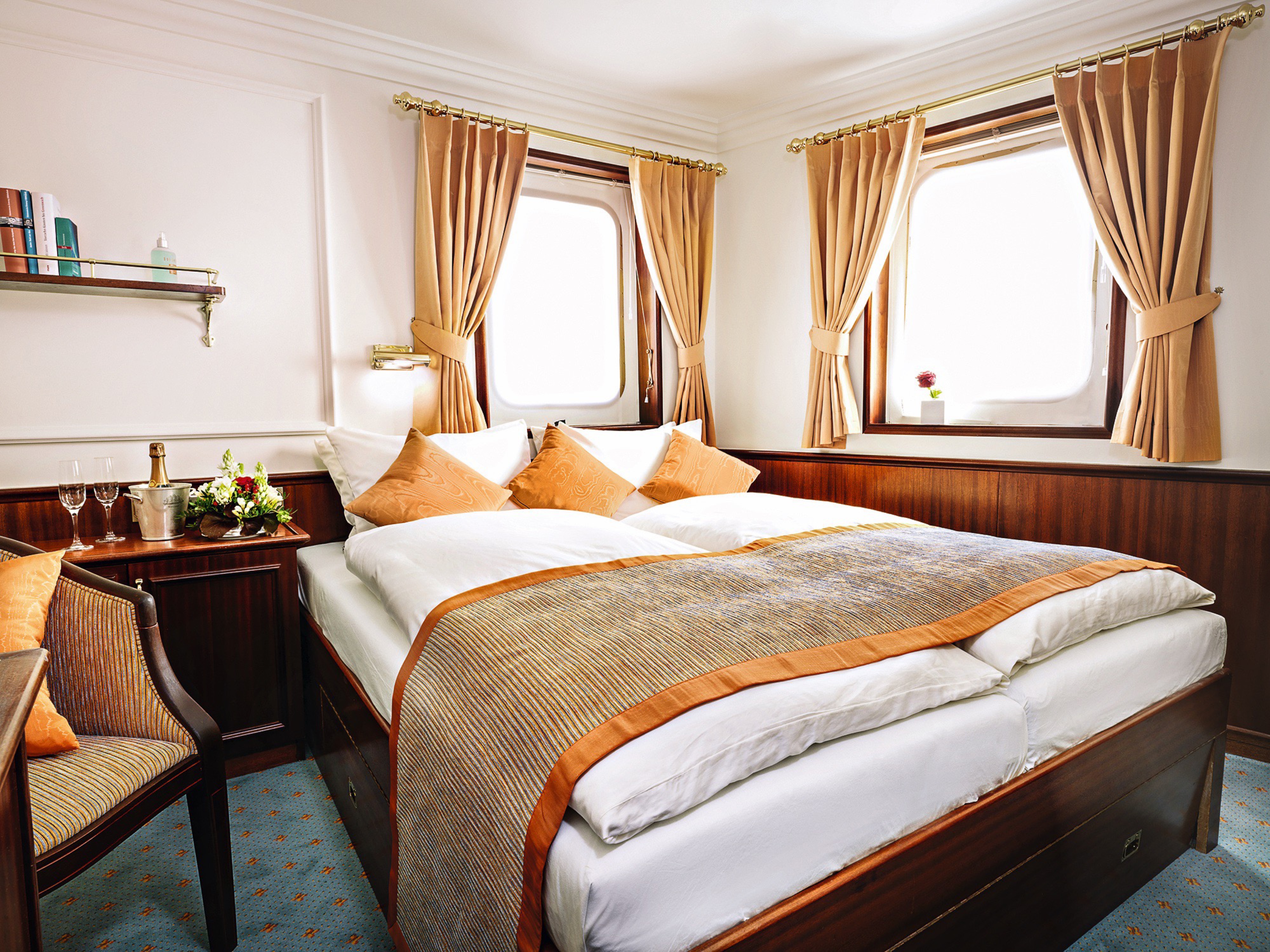
Like all the cabins on the captain’s and lidodeck, these two rooms were only built in the late 1970’s and offer a great deal of comfort. Their outstanding feature is the panoramic windows placed over the corners, which make the overall impression bright and friendly.

Even though the cabins on the captain’s and lidodeck were harmoniously integrated into the SEA CLOUD only later, they naturally follow the standards set in the original area. Their tasteful interior design is a contemporary interpretation of the interior designed by Marjorie Merriweather in the 1930s. The comfortable interior corresponds with the wonderful view of the wide sea.
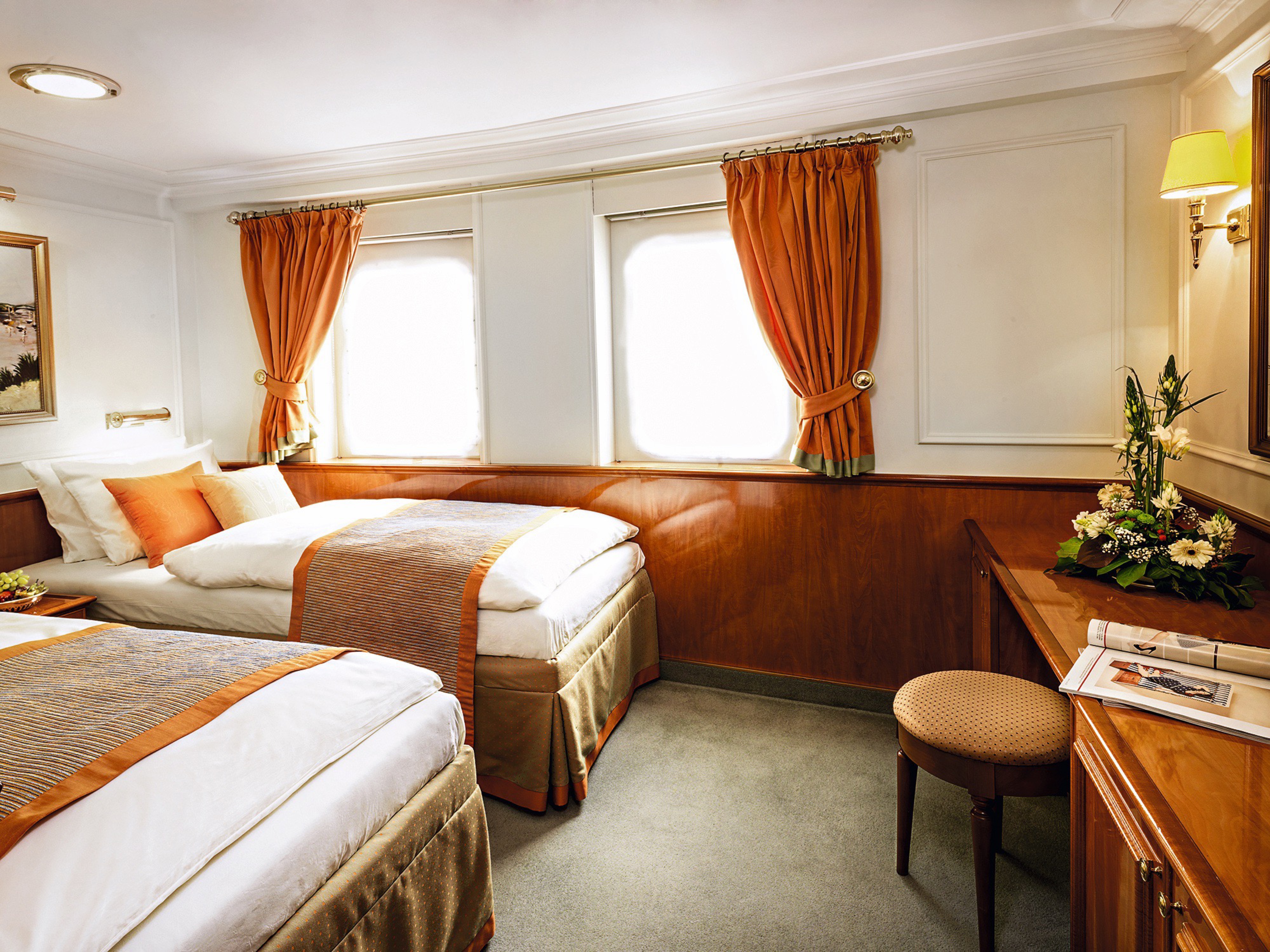
These comfortable cabins have a special maritime charm due to their location between the manoeuvring stations for hoisting and lowering the sails. The deckhouse, which was added during the renovation of the SEA CLOUD, is an oasis of peace, but due to its location on the promenade deck, the cabins are also only one step away from the restaurant and lounge in the superstructure amidships.
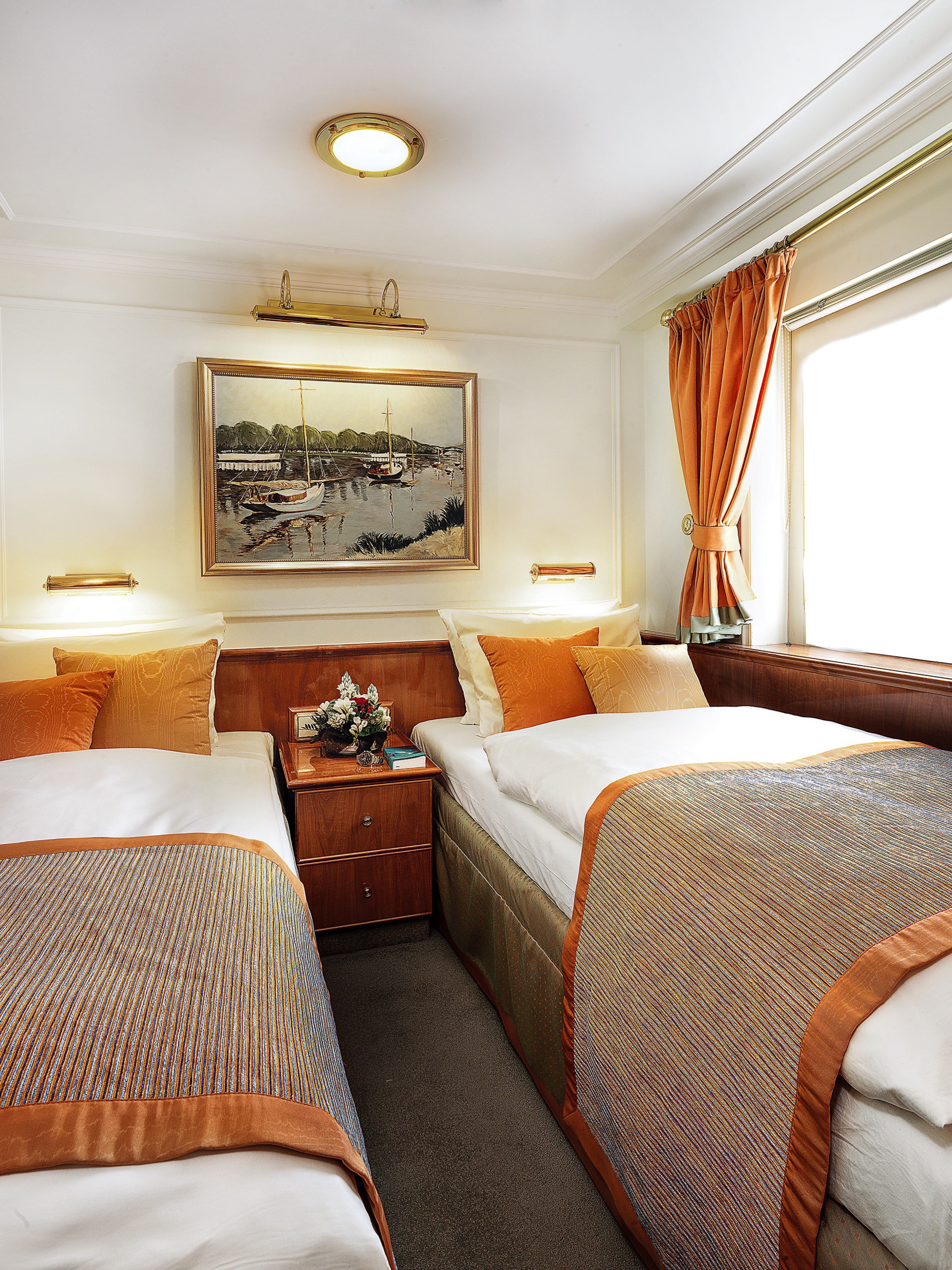
In addition to the comfort and luxury that characterize the SEA CLOUD, both cabins offer a special feature: the most charming place on the tall ship – the so-called Blue Lagoon – can be reached directly from them. The semi-circular, blue cushions that give the ship its name are the traditional place on board for relaxing sunbathing or – at night – for a dreamy view of the impressive starry sky above the ocean.
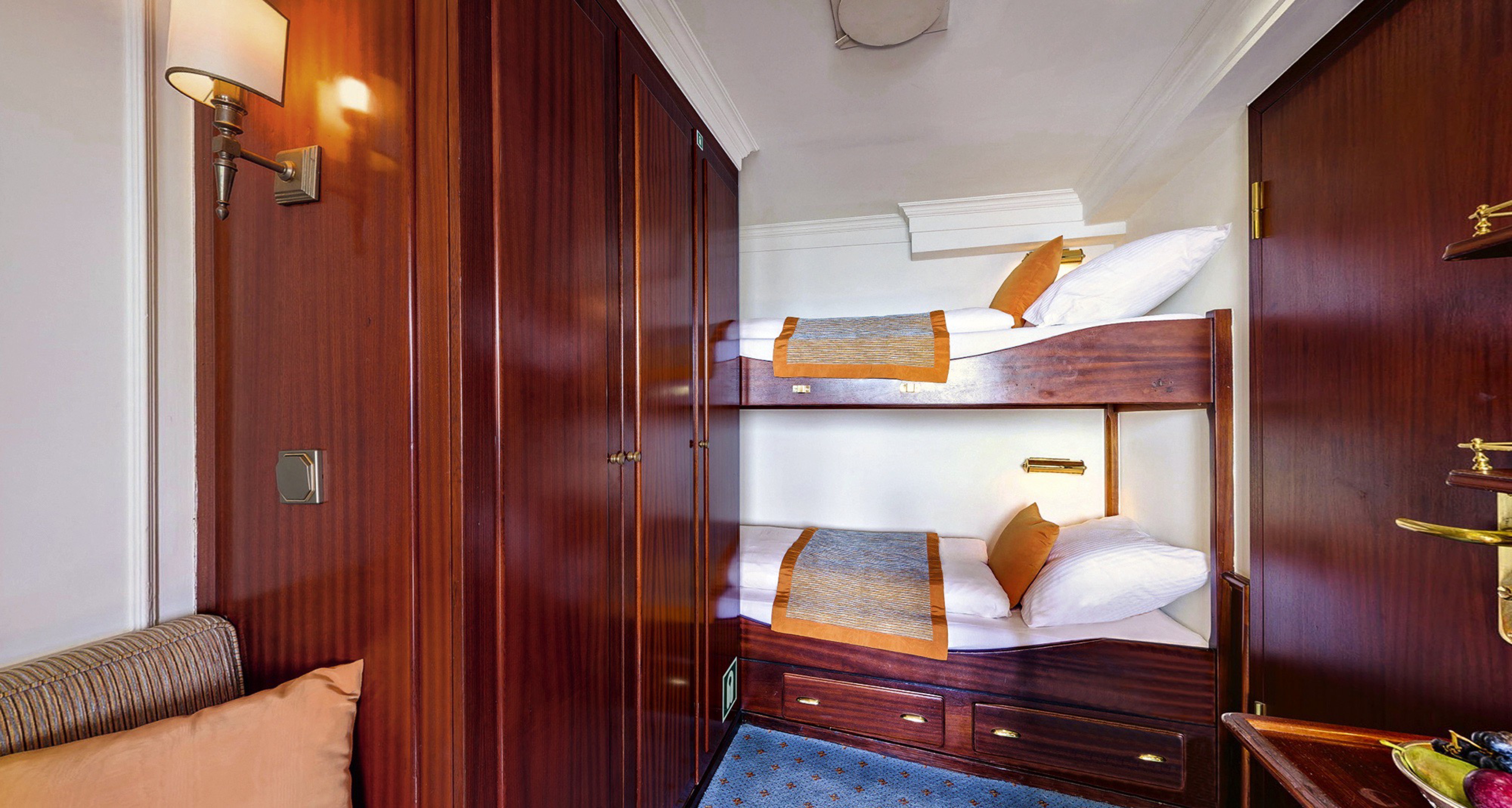
These cabins are the right place for sailing enthusiasts. In Marjorie’s time, the officers of the SEA CLOUD were accommodated here. Their furnishings are correspondingly nautical. The clou: The doors of the cabins below the bridge deck lead directly to the promenade deck, so that at night you can sleep in the perfect maritime ambience with open doors and fresh air.

Guaranteed double cabins: The range of accommodation starts from Cat. 5. You will receive your exact cabin number when arriving on board. The allotment for this category is very limited.
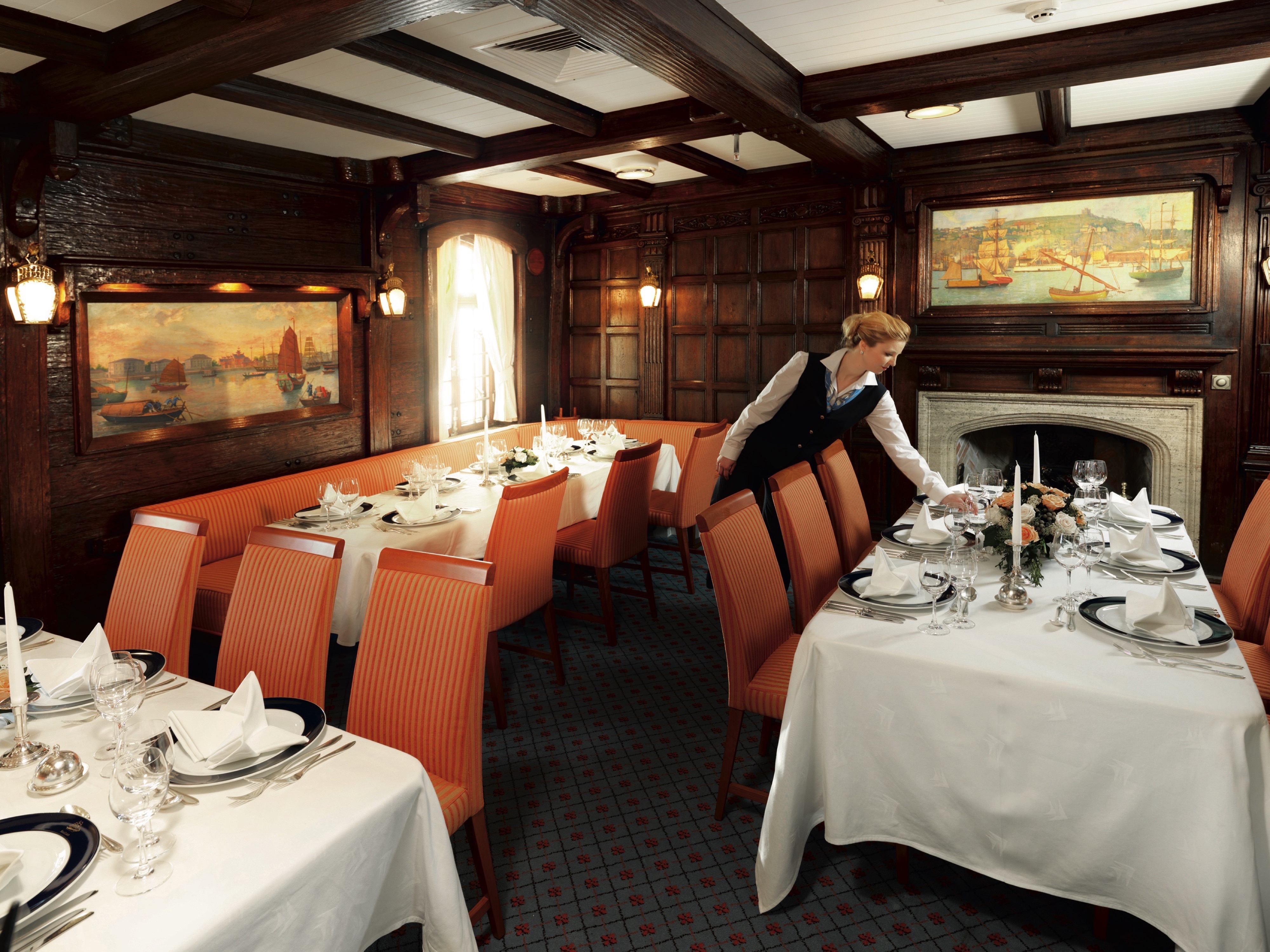
Sea Cloud’s dining room is panelled in warm woods and hung with original oil paintings. It is on the Promenade Deck, in Sea Cloud’s former salon, where Marjorie Merriweather Post received her guests. The chefs come from renowned, first-class restaurants, and offer fresh, contemporary cuisine inflected with regional flavours. They use fresh ingredients sourced locally, from sustainable providers whenever possible. By adding local flavours to a menu that also includes traditional favourites, the chefs aim to give you a greater sense of the cuisine and culture in the region you’re exploring. An array of fresh fruits and delicious, fresh juices are key components of the breakfast buffet. Wines from well-known regions are served with lunch and dinner, and are included in the expedition price. There are fish or meat choices at every meal.
There’s no assigned seating in the dining room; in fact, many tables accommodate uneven numbers. This makes for easy mingling and the fun of sharing breakfast, lunch, or dinner with different new friends, or staff. And independent travellers can count on a welcome everywhere they turn.
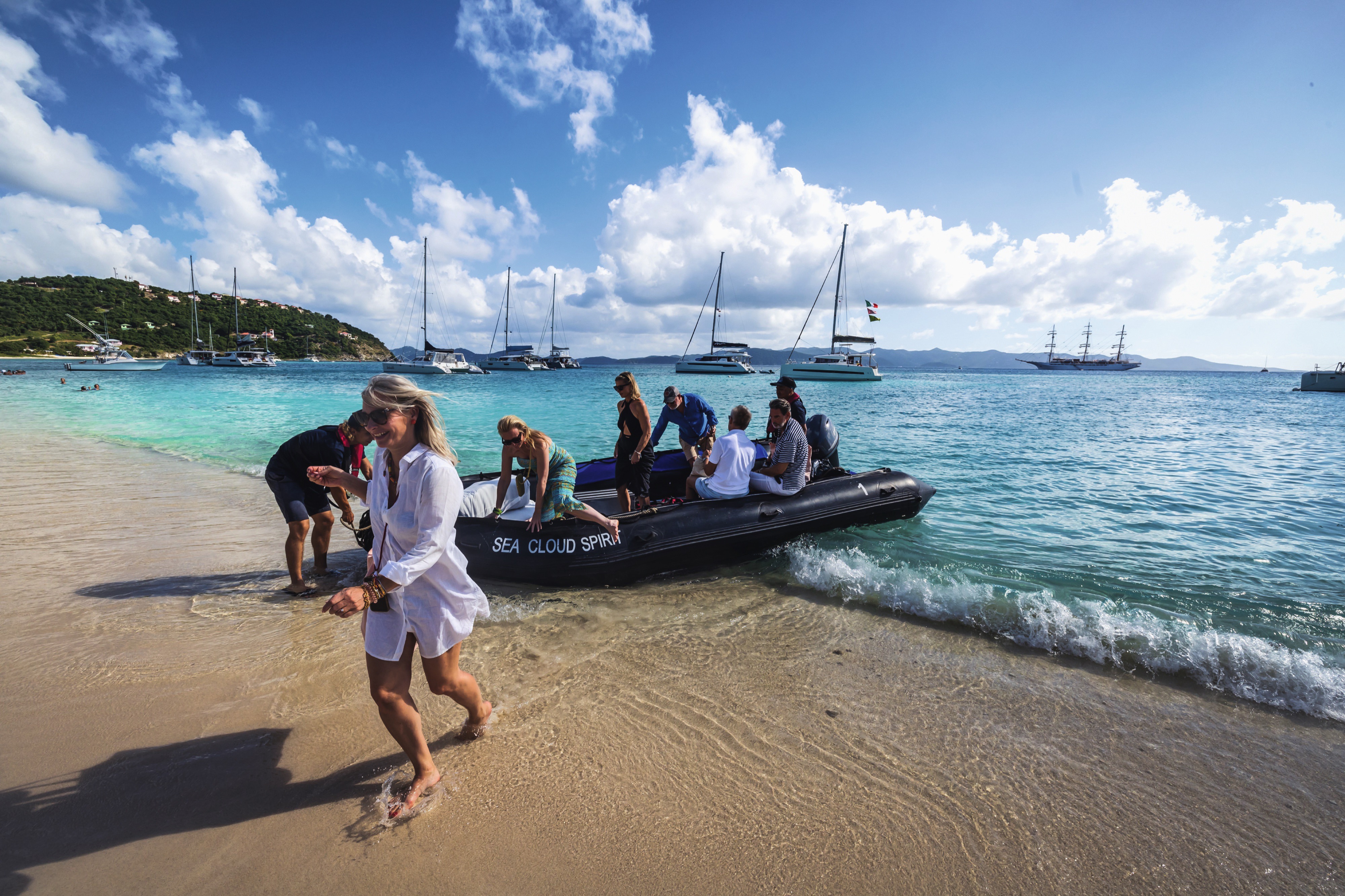
Smaller ships, greater possibilities
Among the many joys of travelling smaller: a quick spin on a zodiac, enjoying the beach barbeques in secluded bays, photo safaris, pausing for a dip in the azure sea. And on selected tours, some exclusive experiences are included – a private concert, an opera house or a palace tour, a culinary visit to a special vineyard, or a front-row seat at a legendary regatta.

Dive in and be active
Whether you want to start your swim directly from the ship or explore the colorful world on the reef – water sports are even more fun under the Caribbean sun. Equipment is available for everyone: Snorkels, fins and stand-up paddles are waiting for you. If you are in the mood for even greater action, let yourself be glided across the crystal clear waters by tubing in the Caribbean.
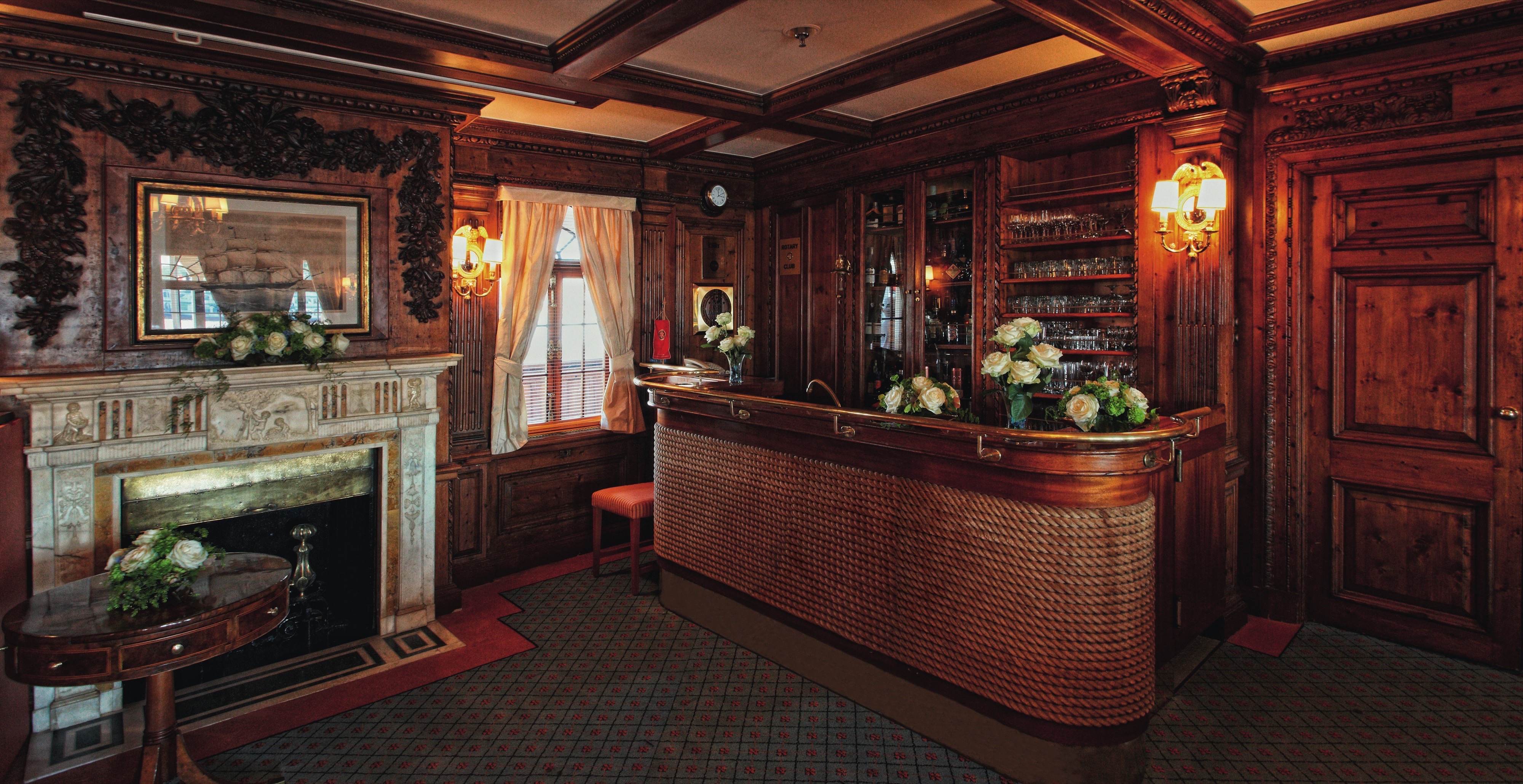
Selected picture books, high-quality literature, popular board games and a writing desk with a laptop can all be found in the cosy lounge on the promenade deck.

If the weather is fine, you might like to sit on the lido deck at lunch time. The tasty snacks served at the buffet in the open air will both whet and satisfy your appetite. At certain times, our onboard pianist will provide pleasant background music to your conversations. The lido bar is a cosy place to wind down the evening. Quite befitting for any traditional sailing ship, the atmosphere can also get rather vibrant when the Crew Shanty Choir makes an appearance.
Not only is the promenade deck a quick route from one end of the ship to the other; in good weather, you will also find some very tasty refreshments there. The coffee, tea and light snacks are ideal for those who rise early, but also to provide sustenance in the afternoon between meals. Just imagine a freshly made waffle with ice cream under the white sails of a ship – that really is pure paradise!
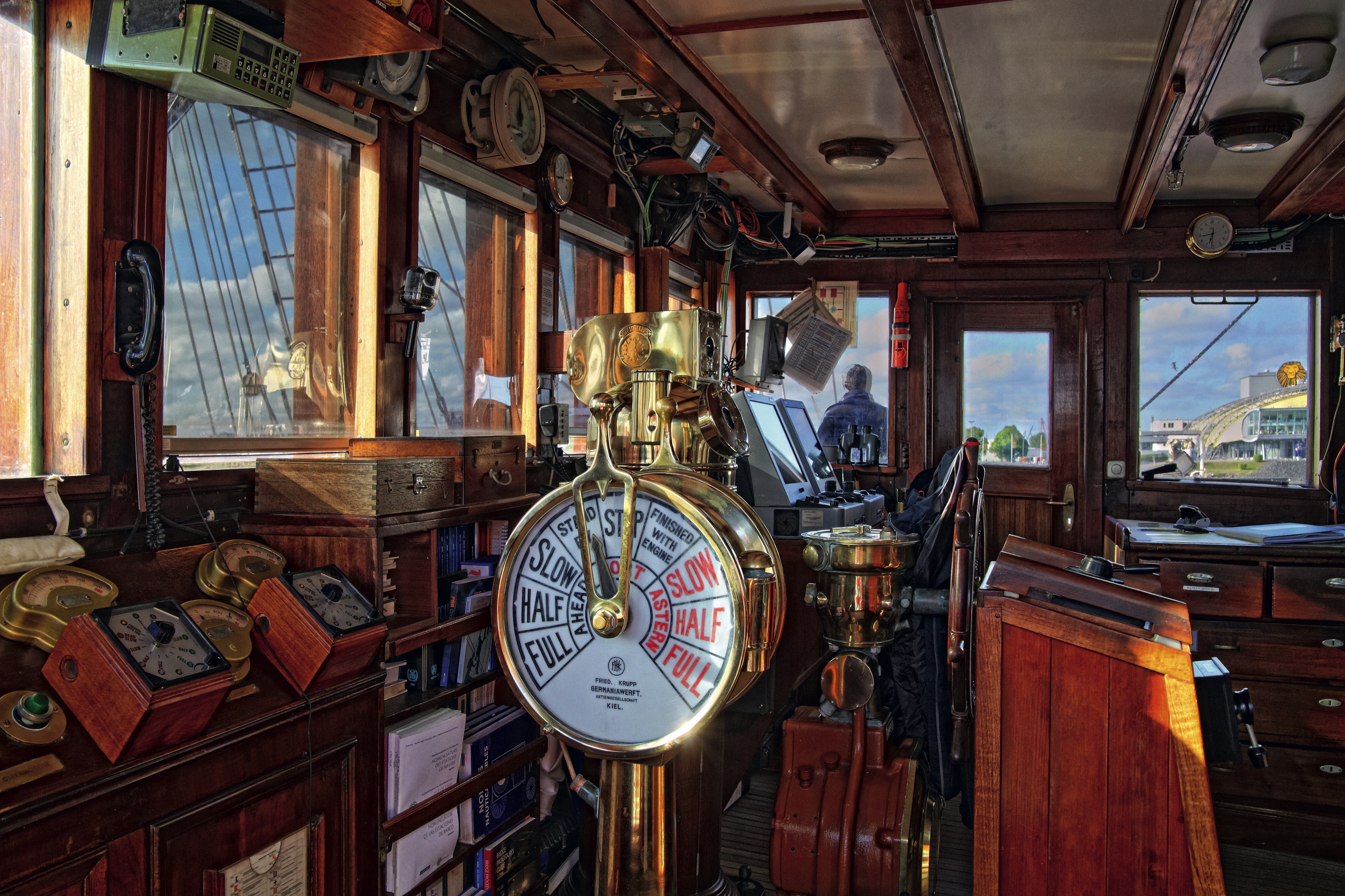
Excellent views of the sea and the 30 majestic sails can of course be enjoyed from the SEA CLOUD’s bridge, where a range of historic nautical instruments almost conceal the modern technology. Operational circumstances permitting, the officers on the bridge will also be happy to answer questions about “their” sailing ship.
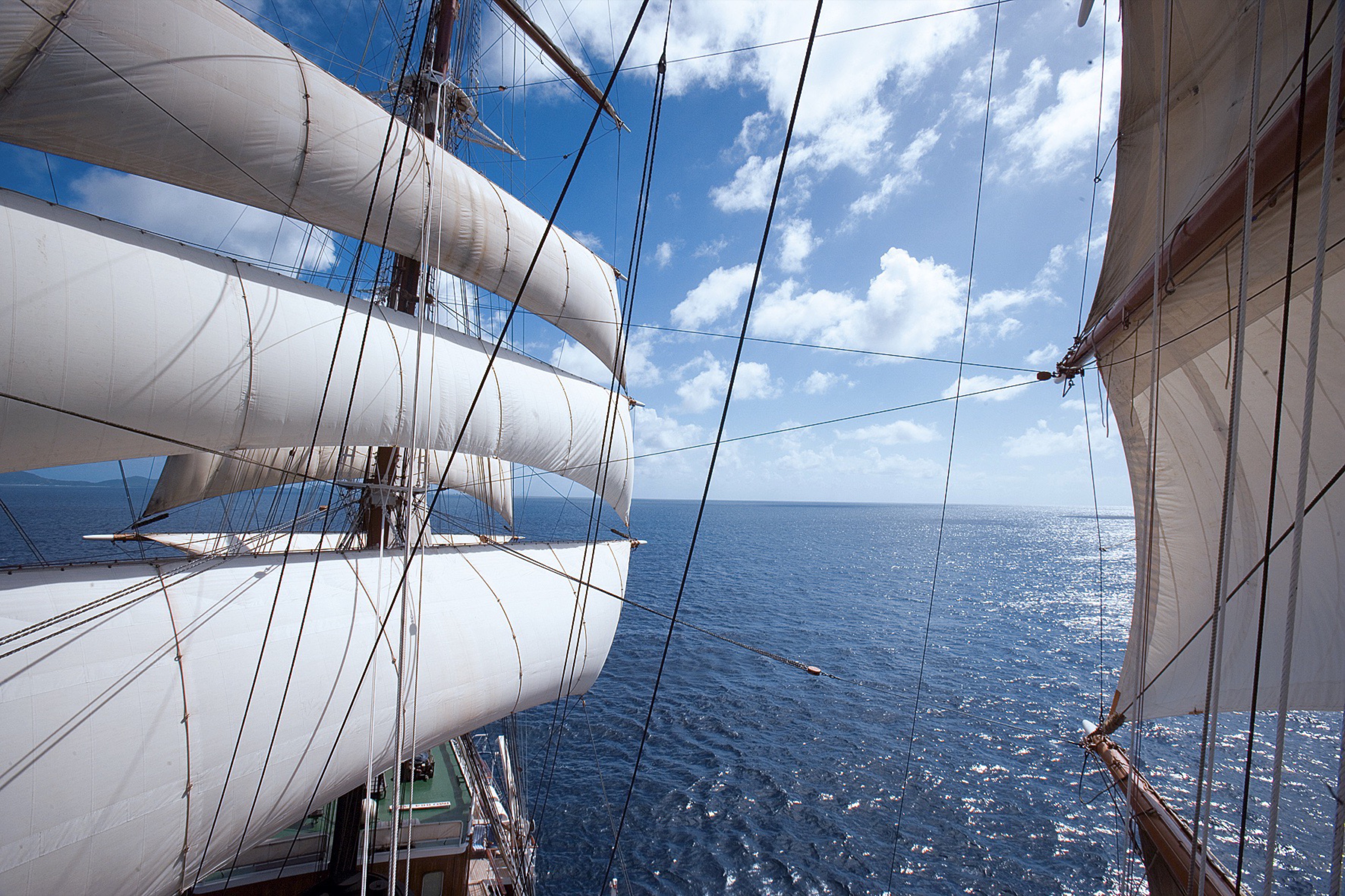
On board the SEA CLOUD there are many wonderful spots where you can relax and unwind: from countless deckchairs, to elegant mahogany benches and the blue lagoon, where you can gaze up at the masts. Watching the movement of the sails and all the traditional tasks associated with a majestic sailing ship is one of the most wonderful activities on the high seas. The traditional rules of cruise travel might be thrown overboard; on board the SEA CLOUD you can travel the way you prefer. If you like, you can jog around the outer promenade deck or borrow snorkelling equipment for a trip ashore. The SEA CLOUD’s onboard zodiac boats do not just take you ashore and back but are also used to tow “Fun Island”, our inflatable water sled. And when conditions are calm enough, the gangway becomes a direct access point for the most beautiful swimming pool in the world: the sea.
The chef will happily accommodate special diet requests—please let us know about any requests in advance so that we may prepare.
During the day, and depending on the weather, a sophisticated summer look is suitable. For the evening, we recommend smart-casual wear. We also kindly request that guests refrain from wearing shorts at evening meals. The Captain’s Dinner (an event which normally takes place twice on each trip – once on short cruises) is a time when our guests tend to opt for a more elegant look. We recommend a suit for men and appropriate smart dress for women. Please remember to take some non-slip shoes with you.
Our tall ships SEA CLOUD and SEA CLOUD II are not accessible for all people with disabilities and are not suitable for wheelchair users. Please contact our cruise consultancy for further details.
Smoking is permitted only on the outer decks outside of meal times. We kindly request that smokers take the comfort of other passengers into consideration. Smoking is prohibited on the blue lagoon deck and covered areas of the spanker and lido deck at all times.
A laptop is available for use on board in the lounge (SEA CLOUD) or in the library (SEA CLOUD II). You can use this laptop or your own laptop to connect to the internet (Wi-Fi) using the access code, however please note that there is a charge for this. The code can be obtained from reception or the purser.
Laundry services available on board are limited to washing and ironing. There is no dry-cleaning available. The washing and ironing service is provided at an additional charge and is carried out overnight. For guests with bookings in Cat. A-C (SEA CLOUD) or Cat. A+B (SEA CLOUD II), this service is free of charge. For safety reasons, passengers are not permitted to iron in their cabins.
Children are of course very welcome on our ships, however there is no supervision or entertainment available for children.
We approach the people and their cultures with respect in all the regions we visit, travelling mindfully through the local environment. By doing this, we can bring our guests closer – in the truest sense of the word – to these places, and what makes each one special.
THE WINDJAMMER EXPERIENCE
For you and us alike, the key attraction of our trips is the chance to sail on the open seas.
We therefore take every opportunity to set sail and be propelled by the sheer power of the wind. That is why the captain will sometimes change the route if the weather requires it. On board our SEA CLOUD tall ships, you’ll experience the elements, as many of the day-to-day activities take place outside.
HAVING AS LITTLE IMPACT AS POSSIBLE
When we do have to start the engines, we utilise low-sulphur marine diesel on all three of our windjammers.
For us, this is standard practice. Even the SEA CLOUD, our very first windjammer, was equipped with this technology right from the start. Our motto: to minimise our impact on the environment yet still make a profound and positive impression on those around us.
A SUSTAINABLE APPROACH TO LIFE ON-BOARD
Avoiding plastic, reducing water usage and protecting the environment.
These are the factors that guide us in the day to day operation of our ships and our ongoing development of eco-friendly alternatives. To cite just one example, our reusable drinks bottles are not only easy on the eye, but also easy on the environment.
QUALITY, NOT QUANTITY
Our ‘small but perfectly formed’ windjammers are able to visit smaller ports, away from the busy routes frequented by large cruise liners.
With a maximum of 64 to 136 passengers, we’re always welcomed in those locations thanks to our approach of visiting local communities rather than overwhelming them. Needless to say, our itineraries also include some classic destinations, though we usually visit these only when the mega-liners have moved on.
BOOSTING THE LOCAL ECONOMY
Procuring supplies locally, working with local, smaller-scale agencies and paying fair prices.
By taking this approach, we see ourselves as a partner for our local service providers, with whom we’ve built relationships based on trust over many years. After all, we want our voyages to benefit both our guests and the communities we visit around the world.
AUTHENTIC CUISINE
Our menus are always a true reflection of the regional cuisine.
This is because our chefs enjoy buying exotic spices, local specialities and freshly caught fish from local markets to bring you – even in a culinary sense – closer to the places we visit.
A MEMBER OF THE FUTOURIS NETWORK
Heading into the future with Futouris.
Preserving the natural and cultural heritage of our world and shaping the future of tourism in a sustainable way is what Futouris stands for. Members of the network are working globally to improve people’s living conditions, preserve biodiversity and protect the environment and climate.
All three ships have a hospital, which is supervised by a ship’s doctor. Medical consultation hours can be found in the daily program. In case of an emergency, the doctor can be reached at any time by calling 911.

- Bridge
- Lido Bar
- Lido Deck
- Spanker Deck
- Category 1 Cabins (Double Bed Cabins)
- Category 2 Cabins (Twin Bed Cabins)

- Purser
- Hospital
- Restaurant
- Lounge
- Category 3 Cabins (Twin-Bed Cabins)
- Category 4 Cabins (Twin-Bed Cabins)
- Category 5 Cabins (Upper-/Lower-Bed)

- Deluxe Category A Cabins (Luxury Owner’s Cabins)
- Deluxe Category B Cabins (De Luxe Original Cabins)
- Deluxe Category C Cabins (De Luxe Outside Cabins)

